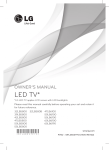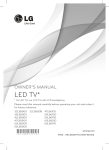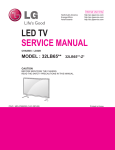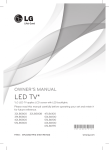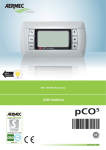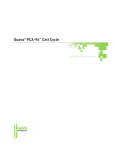Download Creator Electronics CR-TP4102 Service manual
Transcript
LED TV SERVICE MANUAL CHASSIS : LA46B MODEL : 39LB5800 39LB5800-UG CAUTION BEFORE SERVICING THE CHASSIS, READ THE SAFETY PRECAUTIONS IN THIS MANUAL. P/NO : MFL68026206 (1402-REV00) Printed in Korea Recommended Troubleshooting & Repairing Guide: V3.0 –LED & LCD TV Repair Tips ebook V2.0- LCD TV Repair Tips & Case Histories “More information on T-con Board & Mainboard Secret Repair Tips!” V1.0- Collection of LCD TV Repair Tips LCD/LED & 3D TV Repair Membership Site Vol-3 LCD/LED Monitor Repair Case Histories by Jestine Yong Plasma & 3D TV Repair Membership Site Projection TV & DLP/LCD Projector Repair Membership Site Troubleshooting & Repairing LCD TV Guide Plasma TV Repair GuideDisplay Fault Troubleshooting Basic LCD TV Repair Secrets Revealed LCD Monitor Repair Guide SMPS-Switch Mode Power Supply Repair Guide Vol .1- 10 Trus Repair Case Histories of LCD Monitor Testing Electronic Components like a ProFor Beginner Please visit: http://lcd-television-repair.com/newsletter/Recommend.html CONTENTS CONTENTS . ............................................................................................. 2 PRODUCT SAFETY ................................................................................. 3 SPECIFICATION........................................................................................ 4 ADJUSTMENT INSTRUCTION................................................................. 9 BLOCK DIAGRAM................................................................................... 18 EXPLODED VIEW .................................................................................. 19 SCHEMATIC CIRCUIT DIAGRAM .............................................................. Copyright © LG Electronics. Inc. All rights reserved. Only for training and service purposes -2- LGE Internal Use Only SAFETY PRECAUTIONS IMPORTANT SAFETY NOTICE Many electrical and mechanical parts in this chassis have special safety-related characteristics. These parts are identified by in the Schematic Diagram and Exploded View. It is essential that these special safety parts should be replaced with the same components as recommended in this manual to prevent Shock, Fire, or other Hazards. Do not modify the original design without permission of manufacturer. General Guidance Leakage Current Hot Check (See below Figure) Plug the AC cord directly into the AC outlet. An isolation Transformer should always be used during the servicing of a receiver whose chassis is not isolated from the AC power line. Use a transformer of adequate power rating as this protects the technician from accidents resulting in personal injury from electrical shocks. It will also protect the receiver and it's components from being damaged by accidental shorts of the circuitry that may be inadvertently introduced during the service operation. If any fuse (or Fusible Resistor) in this TV receiver is blown, replace it with the specified. When replacing a high wattage resistor (Oxide Metal Film Resistor, over 1 W), keep the resistor 10 mm away from PCB. Keep wires away from high voltage or high temperature parts. Do not use a line Isolation Transformer during this check. Connect 1.5 K / 10 watt resistor in parallel with a 0.15 uF capacitor between a known good earth ground (Water Pipe, Conduit, etc.) and the exposed metallic parts. Measure the AC voltage across the resistor using AC voltmeter with 1000 ohms/volt or more sensitivity. Reverse plug the AC cord into the AC outlet and repeat AC voltage measurements for each exposed metallic part. Any voltage measured must not exceed 0.75 volt RMS which is corresponds to 0.5 mA. In case any measurement is out of the limits specified, there is possibility of shock hazard and the set must be checked and repaired before it is returned to the customer. Leakage Current Hot Check circuit Before returning the receiver to the customer, always perform an AC leakage current check on the exposed metallic parts of the cabinet, such as antennas, terminals, etc., to be sure the set is safe to operate without damage of electrical shock. Leakage Current Cold Check(Antenna Cold Check) With the instrument AC plug removed from AC source, connect an electrical jumper across the two AC plug prongs. Place the AC switch in the on position, connect one lead of ohm-meter to the AC plug prongs tied together and touch other ohm-meter lead in turn to each exposed metallic parts such as antenna terminals, phone jacks, etc. If the exposed metallic part has a return path to the chassis, the measured resistance should be between 1 MΩ and 5.2 MΩ. When the exposed metal has no return path to the chassis the reading must be infinite. An other abnormality exists that must be corrected before the receiver is returned to the customer. Copyright © LG Electronics. Inc. All rights reserved. Only for training and service purposes -3- LGE Internal Use Only SERVICING PRECAUTIONS CAUTION: Before servicing receivers covered by this service manual and its supplements and addenda, read and follow the SAFETY PRECAUTIONS on page 3 of this publication. NOTE: If unforeseen circumstances create conflict between the following servicing precautions and any of the safety precautions on page 3 of this publication, always follow the safety precautions. Remember: Safety First. General Servicing Precautions 1. Always unplug the receiver AC power cord from the AC power source before; a. Removing or reinstalling any component, circuit board module or any other receiver assembly. b. Disconnecting or reconnecting any receiver electrical plug or other electrical connection. c. Connecting a test substitute in parallel with an electrolytic capacitor in the receiver. CAUTION: A wrong part substitution or incorrect polarity installation of electrolytic capacitors may result in an explosion hazard. 2. Test high voltage only by measuring it with an appropriate high voltage meter or other voltage measuring device (DVM, FETVOM, etc) equipped with a suitable high voltage probe. Do not test high voltage by "drawing an arc". 3. Do not spray chemicals on or near this receiver or any of its assemblies. 4. Unless specified otherwise in this service manual, clean electrical contacts only by applying the following mixture to the contacts with a pipe cleaner, cotton-tipped stick or comparable non-abrasive applicator; 10 % (by volume) Acetone and 90 % (by volume) isopropyl alcohol (90 % - 99 % strength) CAUTION: This is a flammable mixture. Unless specified otherwise in this service manual, lubrication of contacts in not required. 5. Do not defeat any plug/socket B+ voltage interlocks with which receivers covered by this service manual might be equipped. 6. Do not apply AC power to this instrument and/or any of its electrical assemblies unless all solid-state device heat sinks are correctly installed. 7. Always connect the test receiver ground lead to the receiver chassis ground before connecting the test receiver positive lead. Always remove the test receiver ground lead last. 8. Use with this receiver only the test fixtures specified in this service manual. CAUTION: Do not connect the test fixture ground strap to any heat sink in this receiver. Electrostatically Sensitive (ES) Devices Some semiconductor (solid-state) devices can be damaged easily by static electricity. Such components commonly are called Electrostatically Sensitive (ES) Devices. Examples of typical ES devices are integrated circuits and some field-effect transistors and semiconductor “chip” components. The following techniques should be used to help reduce the incidence of component damage caused by static by static electricity. 1. Immediately before handling any semiconductor component or semiconductor-equipped assembly, drain off any electrostatic charge on your body by touching a known earth ground. Alternatively, obtain and wear a commercially available discharging wrist strap device, which should be removed to prevent potential shock reasons prior to applying power to the unit under test. Copyright © LG Electronics. Inc. All rights reserved. Only for training and service purposes 2. After removing an electrical assembly equipped with ES devices, place the assembly on a conductive surface such as aluminum foil, to prevent electrostatic charge buildup or exposure of the assembly. 3. Use only a grounded-tip soldering iron to solder or unsolder ES devices. 4. Use only an anti-static type solder removal device. Some solder removal devices not classified as “anti-static” can generate electrical charges sufficient to damage ES devices. 5. Do not use freon-propelled chemicals. These can generate electrical charges sufficient to damage ES devices. 6. Do not remove a replacement ES device from its protective package until immediately before you are ready to install it. (Most replacement ES devices are packaged with leads electrically shorted together by conductive foam, aluminum foil or comparable conductive material). 7. Immediately before removing the protective material from the leads of a replacement ES device, touch the protective material to the chassis or circuit assembly into which the device will be installed. CAUTION: Be sure no power is applied to the chassis or circuit, and observe all other safety precautions. 8. Minimize bodily motions when handling unpackaged replacement ES devices. (Otherwise harmless motion such as the brushing together of your clothes fabric or the lifting of your foot from a carpeted floor can generate static electricity sufficient to damage an ES device.) General Soldering Guidelines 1. Use a grounded-tip, low-wattage soldering iron and appropriate tip size and shape that will maintain tip temperature within the range or 500 °F to 600 °F. 2. Use an appropriate gauge of RMA resin-core solder composed of 60 parts tin/40 parts lead. 3. Keep the soldering iron tip clean and well tinned. 4. Thoroughly clean the surfaces to be soldered. Use a mall wirebristle (0.5 inch, or 1.25 cm) brush with a metal handle. Do not use freon-propelled spray-on cleaners. 5. Use the following unsoldering technique a. Allow the soldering iron tip to reach normal temperature. (500 °F to 600 °F) b. Heat the component lead until the solder melts. c. Quickly draw the melted solder with an anti-static, suctiontype solder removal device or with solder braid. CAUTION: Work quickly to avoid overheating the circuit board printed foil. 6. Use the following soldering technique. a. Allow the soldering iron tip to reach a normal temperature (500 °F to 600 °F) b. First, hold the soldering iron tip and solder the strand against the component lead until the solder melts. c. Quickly move the soldering iron tip to the junction of the component lead and the printed circuit foil, and hold it there only until the solder flows onto and around both the component lead and the foil. CAUTION: Work quickly to avoid overheating the circuit board printed foil. d. Closely inspect the solder area and remove any excess or splashed solder with a small wire-bristle brush. -4- LGE Internal Use Only IC Remove/Replacement Some chassis circuit boards have slotted holes (oblong) through which the IC leads are inserted and then bent flat against the circuit foil. When holes are the slotted type, the following technique should be used to remove and replace the IC. When working with boards using the familiar round hole, use the standard technique as outlined in paragraphs 5 and 6 above. 3. Solder the connections. CAUTION: Maintain original spacing between the replaced component and adjacent components and the circuit board to prevent excessive component temperatures. Circuit Board Foil Repair Excessive heat applied to the copper foil of any printed circuit board will weaken the adhesive that bonds the foil to the circuit board causing the foil to separate from or "lift-off" the board. The following guidelines and procedures should be followed whenever this condition is encountered. Removal 1. Desolder and straighten each IC lead in one operation by gently prying up on the lead with the soldering iron tip as the solder melts. 2. Draw away the melted solder with an anti-static suction-type solder removal device (or with solder braid) before removing the IC. Replacement 1. Carefully insert the replacement IC in the circuit board. 2. Carefully bend each IC lead against the circuit foil pad and solder it. 3. Clean the soldered areas with a small wire-bristle brush. (It is not necessary to reapply acrylic coating to the areas). At IC Connections To repair a defective copper pattern at IC connections use the following procedure to install a jumper wire on the copper pattern side of the circuit board. (Use this technique only on IC connections). "Small-Signal" Discrete Transistor Removal/Replacement 1. Remove the defective transistor by clipping its leads as close as possible to the component body. 2. Bend into a "U" shape the end of each of three leads remaining on the circuit board. 3. Bend into a "U" shape the replacement transistor leads. 4. Connect the replacement transistor leads to the corresponding leads extending from the circuit board and crimp the "U" with long nose pliers to insure metal to metal contact then solder each connection. Power Output, Transistor Device Removal/Replacement 1. Heat and remove all solder from around the transistor leads. 2. Remove the heat sink mounting screw (if so equipped). 3. Carefully remove the transistor from the heat sink of the circuit board. 4. Insert new transistor in the circuit board. 5. Solder each transistor lead, and clip off excess lead. 6. Replace heat sink. Diode Removal/Replacement 1. Remove defective diode by clipping its leads as close as possible to diode body. 2. Bend the two remaining leads perpendicular y to the circuit board. 3. Observing diode polarity, wrap each lead of the new diode around the corresponding lead on the circuit board. 4. Securely crimp each connection and solder it. 5. Inspect (on the circuit board copper side) the solder joints of the two "original" leads. If they are not shiny, reheat them and if necessary, apply additional solder. 1. Carefully remove the damaged copper pattern with a sharp knife. (Remove only as much copper as absolutely necessary). 2. carefully scratch away the solder resist and acrylic coating (if used) from the end of the remaining copper pattern. 3. Bend a small "U" in one end of a small gauge jumper wire and carefully crimp it around the IC pin. Solder the IC connection. 4. Route the jumper wire along the path of the out-away copper pattern and let it overlap the previously scraped end of the good copper pattern. Solder the overlapped area and clip off any excess jumper wire. At Other Connections Use the following technique to repair the defective copper pattern at connections other than IC Pins. This technique involves the installation of a jumper wire on the component side of the circuit board. 1. Remove the defective copper pattern with a sharp knife. Remove at least 1/4 inch of copper, to ensure that a hazardous condition will not exist if the jumper wire opens. 2. Trace along the copper pattern from both sides of the pattern break and locate the nearest component that is directly connected to the affected copper pattern. 3. Connect insulated 20-gauge jumper wire from the lead of the nearest component on one side of the pattern break to the lead of the nearest component on the other side. Carefully crimp and solder the connections. CAUTION: Be sure the insulated jumper wire is dressed so the it does not touch components or sharp edges. Fuse and Conventional Resistor Removal/Replacement 1. Clip each fuse or resistor lead at top of the circuit board hollow stake. 2. Securely crimp the leads of replacement component around notch at stake top. Copyright © LG Electronics. Inc. All rights reserved. Only for training and service purposes -5- LGE Internal Use Only SPECIFICATION NOTE : Specifications and others are subject to change without notice for improvement. 1. Application range 1.1. This spec sheet is applied all of the 32”, 39”, 42”, 47”, 50”, 55”, 60, 65” LED TV with LA46B chassis. 1.2. Not included spec and each product spec in this spec sheet apply correspondingly to the following each country standard and requirement of Buyer 2. Test condition Each part is tested as below without special notice. 1) Temperature : 20 ºC ± 5 ºC 2) Relative Humidity: 65 % ± 10 % 3) Power Voltage Market Input voltage Frequency USA 110~240V 50/60Hz Remark Standard Voltage of each product is marked by models 4) Specification and performance of each parts are followed each drawing and specification by part number in accordance with BOM 5) The receiver must be operated for about 20 minutes prior to the adjustment 3. Test method 1) Performance: LGE TV test method followed 2) Demanded other specification - Safety : UL, CSA, IEC specification - EMC: FCC, ICES, IEC specification - Wireless : WirelessHD Specification (Option) Copyright © LG Electronics. Inc. All rights reserved. Only for training and service purposes -6- LGE Internal Use Only 4. General Specification No Item Specification Remark 1 Market 1) North America 2 Television System NTSC-M, ATSC, 64 & 256 QAM 3 Input Voltage AC 100 ~ 240V 50/60Hz 4 Available Channel 1) VHF : 02~13 2) UHF : 14~69 3) DTV : 02-69 4) CATV : 01~135 5) CADTV : 01~135 5 Aspect Ratio 16:9 6 Tuning System FS 7 LCD Module LC550DUE-FGA3 LGD 55LB5800-UA T500HVF05.0 AUO 50LB5800-UA LC550DUE-FGA4 LGD 55LB6100-UG LC500DUE-FGA4 LGD 50LB5800-UG, 50LB6100-UG LC470DUE-FGA4 LGD 47LB5800-UG, 47LB6100-UG LC420DUE-FGA4 LGD 42LB5800-UG LC650DUF-FGA1 LGD 65LB6190-UD HC600DUF-VHHS2 Sharp 60LB6100-UG T550HVF04.2 AUO 55LB6100-UG/55LB5800-UG NC500DUN-VXBP2 INX 50LB6100-UG/50LB5800-UG T420HVF07.0 AUO 42LB5800-UG NC390DUN-VXBP2 INX 39LB5800-UG LC320DUE-FGA4 LGD 32LB5800-UG NC320DXN-VSBP2 Sharp 32LB580B-UG LC320DXE-FGA4 LGD 32LB580B-UG 8 Operating Environment 1) Temp : 0 ~ 40 deg 2) Humidity : ~ 80 % 9 Storage Environment 1) Temp : -20 ~ 60 deg 2) Humidity : ~ 85 % Copyright © LG Electronics. Inc. All rights reserved. Only for training and service purposes -7- LGE Internal Use Only 5. Supported video resolutions 5.1. Component 2D input(Y, CB/PB, CR/PR) No Resolution H-freq(kHz) V-freq.(Hz) Pixel clock(MHz) Proposed 1. 720*480 15.73 60 13.5135 SDTV ,DVD 480I 2. 720*480 15.73 59.94 13.5 SDTV ,DVD 480I 3. 720*480 31.50 60 27.027 SDTV 480P 4. 720*480 31.47 59.94 27.0 SDTV 480P 5. 1280*720 45.00 60.00 74.25 HDTV 720P 6. 1280*720 44.96 59.94 74.176 HDTV 720P 7. 1920*1080 33.75 60.00 74.25 HDTV 1080I 8. 1920*1080 33.72 59.94 74.176 HDTV 1080I 9. 1920*1080 26.97 23.976 74.176 HDTV 1080P 10. 1920*1080 27.00 24.00 74.25 HDTV 1080P 11. 1920*1080 33.71 29.97 74.176 HDTV 1080P 12. 1920*1080 33.75 30.00 74.25 HDTV 1080P 13. 1920*1080 67.432 59.94 148.352 HDTV 1080P 14. 1920*1080 67.50 60 148.50 HDTV 1080P 5.2. HDMI Input (PC/DTV) No. Resolution H-freq(kHz) V-freq.(kHz) Pixel clock(MHz) PC Proposed DDC 1 640*350 31.468 70.09 25.17 EGA X 2 720*400 31.469 70.08 28.32 DOS O 3 640*480 31.469 59.94 25.17 VESA(VGA) O 4 800*600 37.879 60.31 40.00 VESA(SVGA) O 5 1024*768 48.363 60.00 65.00 VESA(XGA) O 6 1152*864 54.348 60.053 80.002 VESA O 7 1360*768 47.712 60.015 85.50 VESA (WXGA) X 8 1280*1024 63.981 60.020 108.00 VESA (SXGA) O 9 1920*1080 67.5 60 148.5 HDTV 1080P O DTV 1 720*480 31.50 60 27.027 SDTV 480P 2 720*480 31.469 59.94 27.00 SDTV 480P 3 1280*720 45.00 60.00 74.25 HDTV 720P 4 1280*720 44.96 59.94 74.176 HDTV 720P 5 1920*1080 33.75 60.00 74.25 HDTV 1080I 6 1920*1080 33.72 59.94 74.176 HDTV 1080I 7 1920*1080 67.500 60 148.50 HDTV 1080P 8 1920*1080 67.43 59.94 148.352 HDTV 1080P 9 1920*1080 27.000 24.000 74.25 HDTV 1080P 10 1920*1080 26.97 23.97 74.176 HDTV 1080P 11 1920*1080 33.75 30.000 74.25 HDTV 1080P 12 1920*1080 33.716 29.976 74.176 HDTV 1080P Copyright © LG Electronics. Inc. All rights reserved. Only for training and service purposes -8- LGE Internal Use Only ADJUSTMENT INSTRUCTION 1. Application This spec. sheet applies to LA46B Chassis applied LED TV all models manufactured in TV factory 2. Specification (1) Because this is not a hot chassis, it is not necessary to use an isolation transformer. However, the use of isolation transformer will help protect test instrument. (2) Adjustment must be done in the correct order. (3) The adjustment must be performed in the circumstance of 25 ±5 ºC of temperature and 65±10% of relative humidity if there is no specific designation (4) The input voltage of the receiver must keep 100~240V, 50/60Hz (5) At first Worker must turn on the SET by using Power Only key. (6) The receiver must be operated for about 5 minutes prior to the adjustment when module is in the circumstance of over 15 ºC In case of keeping module is in the circumstance of 0°C, it should be placed in the circumstance of above 15°C for 2 hours In case of keeping module is in the circumstance of below -20°C, it should be placed in the circumstance of above 15°C for 3 hours. ※ Caution When still image is displayed for a period of 20 minutes or longer (especially where W/B scale is strong. Digital pattern 13ch and/or Cross hatch pattern 09ch), there can some afterimage in the black level area 4. MAIN PCBA Adjustments 4.1. ADC Calibration - A n ADC calibration is not necessary because MAIN SoC (LGExxxx) is already calibrated from IC Maker 4.2. M AC Address, ESN Key and Widevine Key, DTCP Key, HDCP1.4, HDCP2.0 download 4.2.1. Equipment & Condition 1) Play file: keydownload.exe 4.2.2. Communication Port connection 1) Key Write: Com 1,2,3,4 and 115200 (Baudrate) 2) Barcode: Com 1,2,3,4 and 9600 (Baudrate) 4.2.3. Download process 1) Select the download items. 2) Mode check: Online Only 3) Check the test process - U S, Canada models: DETECT -> MAC_WRITE -> WIDEVINE_WRITE 4) Play : START 5) Check of result: Ready, Test, OK or NG 6) Printer out (MAC Address Label) 4.2.4. Communication Port connection 1) Connect: PCBA Jig -> RS-232C Port == PC -> RS-232C Port 3. Adjustment items 3.1. Final assembly adjustment (1) White Balance adjustment (2) RS-232C functionality check (3) Factory Option setting per destination (4) Shipment mode setting (In-Stop) (5) GND and HI-POT test 4.2.5. Download 1) US, Canada models (14Y LED TV + MAC + Widevine + ESN Key + DTCP Key + HDCP1.4 and HDCP2.0) 3.2. Appendix (1) Tool option menu, USB Download (S/W Update, Option and Service only) (2) Manual adjustment for ADC calibration and White balance. (3) Shipment conditions, Channel pre-set 4.2.6. Inspection - In INSTART menu, check these keys. Copyright © LG Electronics. Inc. All rights reserved. Only for training and service purposes -9- LGE Internal Use Only 4.3. LAN port Inspection (Ping Test) 4.4.3. EDID DATA 4.4.3.1. . 2D_8bit_PCM(US) _ xvYCC : off (HD) HDMI EDID 2D_8bit_PCM(US)_xvYCC : off (HD) 4.3.1. Equipment setting 1) Play the LAN Port Test PROGRAM. 2) Input IP set up for an inspection to Test Program. - IP number: 12.12.2.2 4.3.2. LAN PORT inspection (PING TEST) 1) Play the LAN Port Test Program. 2) Connect each other LAN Port Jack. 3) Play Test (F9) button and confirm OK Message. 4) Remove LAN CABLE ▪Reference - HDMI1 ~ HDMI3 - In the data of EDID, bellows may be different by S/W or Input mode. ⓐ Product ID HEX EDID Table DDC Function 0001 0100 Analog 0001 0100 Digital ⓑ Serial No: Controlled on production line. ⓒ Month, Year: Controlled on production line: ex) Monthly : ‘01’ -> ‘01’ Year : ‘2014’ -> ‘18’ ⓓ Model Name(Hex): LGTV Chassis MODEL NAME(HEX) LA46B 00 00 00 FC 00 4C 47 20 54 56 0A 20 20 20 20 20 20 20 ⓔ Checksum(LG TV): Changeable by total EDID data. ⓔ1 4.4. EDID Download 4.4.1 Overview ▪ I t is a VESA regulation. A PC or a MNT will display an optimal resolution through information sharing without any necessity of user input. It is a realization of “Plug and Play”. 4.4.2 Equipment ▪ Since embedded EDID data is used, EDID download JIG, HDMI cable and D-sub cable are not need. ▪ Adjust remocon Copyright © LG Electronics. Inc. All rights reserved. Only for training and service purposes - 10 - ⓔ2 ⓔ3 HDMI1 A5 0C X HDMI2 A5 FC X HDMI3 A5 EC X ⓕ Vendor Specific(HDMI) INPUT MODEL NAME(HEX) HDMI1 67 03 0C 00 10 00 80 1E HDMI2 67 03 0C 00 20 00 80 1E HDMI3 67 03 0C 00 30 00 80 1E LGE Internal Use Only 4.4.3.2. 2D_8bit_PCM(US) _ xvYCC : off HDMI EDID 2D_8bit_PCM(US)_xvYCC : off 4.4.3.3. 2D_10bit_PCM(US) _ xvYCC : off HDMI EDID 2D_10bit_PCM(US)_xvYCC : off ▪Reference - HDMI1 ~ HDMI3 - In the data of EDID, bellows may be different by S/W or Input mode. ▪Reference - HDMI1 ~ HDMI3 - In the data of EDID, bellows may be different by S/W or Input mode. ⓐ Product ID ⓐ Product ID HEX EDID Table DDC Function HEX EDID Table DDC Function 0001 0100 Analog 0001 0100 Analog 0001 0100 Digital 0001 0100 Digital ⓑ Serial No: Controlled on production line. ⓒ Month, Year: Controlled on production line: ex) Monthly : ‘01’ -> ‘01’ Year : ‘2014’ -> ‘18’ ⓓ Model Name(Hex): LGTV ⓑ Serial No: Controlled on production line. ⓒ Month, Year: Controlled on production line: ex) Monthly : ‘01’ -> ‘01’ Year : ‘2014’ -> ‘18’ ⓓ Model Name(Hex): LGTV Chassis MODEL NAME(HEX) Chassis MODEL NAME(HEX) LA46B 00 00 00 FC 00 4C 47 20 54 56 0A 20 20 20 20 20 20 20 LA46B 00 00 00 FC 00 4C 47 20 54 56 0A 20 20 20 20 20 20 20 ⓔ Checksum(LG TV): Changeable by total EDID data. ⓔ1 ⓔ2 ⓔ3 HDMI1 E7 1C X HDMI2 E7 0C HDMI3 E7 FC ⓔ Checksum(LG TV): Changeable by total EDID data. ⓔ1 ⓔ2 ⓔ3 HDMI1 E7 02 X X HDMI2 E7 F2 X X HDMI3 E7 E2 X ⓕ Vendor Specific(HDMI) ⓕ Vendor Specific(HDMI) INPUT MODEL NAME(HEX) INPUT MODEL NAME(HEX) HDMI1 67 03 0C 00 10 00 80 1E HDMI1 67 03 0C 00 10 00 B8 2D HDMI2 67 03 0C 00 20 00 80 1E HDMI2 67 03 0C 00 20 00 B8 2D HDMI3 67 03 0C 00 30 00 80 1E HDMI3 67 03 0C 00 30 00 B8 2D Copyright © LG Electronics. Inc. All rights reserved. Only for training and service purposes - 11 - LGE Internal Use Only 5. Final Assembly Adjustment 5.1.4. Adjustment Command (Protocol) (1) RS-232C Command used during auto-adj. 5.1. White Balance Adjustment RS-232C COMMAND 5.1.1. Overview 5.1.1.1. W/B adj. Objective & How-it-works (1) Objective: To reduce each Panel’s W/B deviation (2) How-it-works: When R/G/B gain in the OSD is at 192, it means the panel is at its Full Dynamic Range. In order to prevent saturation of Full Dynamic range and data, one of R/G/B is fixed at 192, and the other two is lowered to find the desired value. (3) Adj. condition: normal temperature - Surrounding Temperature: 25±5 °C - Warm-up time: About 5 Min - Surrounding Humidity: 20% ~ 80% - Before White balance adjustment, Keep power on status, don’t power off 5.1.1.2. Adj. condition and cautionary items (1) Lighting condition in surrounding area surrounding lighting should be lower 10 lux. Try to isolate adj. area into dark surrounding. (2) Probe location: Color Analyzer (CA-210) probe should be within 10cm and perpendicular of the module surface (80°~ 100°) (3) Aging time - A fter Aging Start, Keep the Power ON status during 5 Minutes. - In case of LCD, Back-light on should be checked using no signal or Full-white pattern. 5.1.2. Equipment (1) Color Analyzer: CA-210 (NCG: CH 9 / WCG: CH12 / LED: CH14) (2) A dj. Computer (During auto adj., RS-232C protocol is needed) (3) Adjust Remocon (4) V ideo Signal Generator MSPG-925F 720p/204-Gray (Model: 217, Pattern: 49) ※ Color Analyzer Matrix should be calibrated using CS-1000 5.1.3. Equipment connection Copyright © LG Electronics. Inc. All rights reserved. Only for training and service purposes Explanation CMD DATA ID Wb 00 00 Begin White Balance adj. Wb 00 ff End White Balance adj. (internal pattern disappears ) (2) Adjustment Map Adj. item Cool Medium Warm Command (lower caseASCII) Data Range (Hex.) CMD1 CMD2 MIN MAX R Gain j g 00 C0 G Gain j h 00 C0 B Gain j i 00 C0 R Gain j a 00 C0 G Gain j b 00 C0 B Gain j c 00 C0 R Gain j d 00 C0 G Gain j e 00 C0 B Gain j f 00 C0 5.1.5. Adjustment method 5.1.5.1. Auto WB calibration (1) Set TV in ADJ mode using P-ONLY key (or POWER ON key) (2) Place optical probe on the center of the display - It need to check probe condition of zero calibration before adjustment. (3) Connect RS-232C Cable (4) Select mode in ADJ Program and begin a adjustment. (5) When WB adjustment is completed with OK message, check adjustment status of pre-set mode (Cool, Medium, Warm) (6) Remove probe and RS-232C cable. ▪ W/B Adj. must begin as start command “wb 00 00” , and finish as end command “wb 00 ff”, and Adj. offset if need - 12 - LGE Internal Use Only 5.1.5.2. Manual adjustment (1) Set TV in Adj. mode using POWER ON (2) Z ero Calibrate the probe of Color Analyzer, then place it on the center of LCD module within 10cm of the surface.. (3) P ress ADJ key -> EZ adjust using adj. R/C à 9. WhiteBalance then press the cursor to the right (KEY►). When KEY(►) is pressed 206 Gray internal pattern will be displayed. (4) Adjust Cool modes (i) F ix the one of R/G/B gain to 192 (default data) and decrease the others. (If G gain is adjusted over 172 and R and B gain less than 192 , Adjust is O.K.) (ii) If G gain is less than 172, Increase G gain by up to 172, and then increase R gain and G gain same amount of increasing G gain. (iii) If R gain or B gain is over 255, R eadjust G gain less than 172, Conform to R gain is 255 or B gain is 255 (5) Adjust two modes (Medium / Warm) Fix the one of R/G/B gain to 192 (default data) and decrease the others. (6) Adj. is completed, Exit adjust mode using “EXIT” key on Remote controller. ▪ If internal pattern is not available, use RF input. In EZ Adj. menu. 6.White Balance, you can select one of 2 Test-pattern: ON, OFF. Default is inner (ON). By selecting OFF, you can adjust using RF signal in 206 Gray pattern. 5.1.7. Reference (White balance table) ▪ S tandard color coordinate and temperature using CA-210(CH-14) – by aging time (1) Normal line in Korea (From January to February) LGD (LB5xxx, LB6xxx, LB7xxx, LB8xxx). Aging time (Min) Mode Coordinate X Temp Y △uv Medium Warm Y X Y X Y 271 270 286 289 313 329 1 0-2 286 295 301 314 328 354 2 3-5 284 290 299 309 326 349 3 6-9 282 287 297 306 324 346 4 10-19 279 283 294 302 321 342 5 20-35 276 278 291 297 318 337 6 36-49 274 275 289 294 316 334 7 50-79 273 272 288 291 315 331 8 80-119 272 271 287 290 314 330 9 Over 120 271 270 286 289 313 329 ▪ S tandard color coordinate and temperature using CA-210(CH-14) – by aging time (2) Normal line (From March to December) : LGD (LB5xxx, LB6xxx, LB7xxx, LB8xxx) Aging time (Min) 5.1.6. Reference (White Balance Adj. coordinate and color temperature) ▪ Luminance: 204 Gray, 80IRE ▪ Standard color coordinate and temperature using CS-1000 (over 26 inch) Cool X Cool Medium Warm X Y X Y X Y 271 270 286 289 313 329 1 0-2 282 289 297 308 324 348 2 3-5 281 287 296 306 323 346 3 6-9 279 284 294 303 321 343 4 10-19 277 280 292 299 319 339 20-35 275 277 290 296 317 336 Cool 0.271 0.270 13,000K 0.0000 5 Medium 0.286 0.289 9,300K 0.0000 6 36-49 274 274 289 293 316 333 Warm 0.313 0.329 6,500K 0.0000 7 50-79 273 272 288 291 315 331 8 80-119 272 271 287 290 314 330 9 Over 120 271 270 286 289 313 329 ▪ S tandard color coordinate and temperature using CA-210(CH 18) – ALEF Mode Coordinate X Y Temp △uv Cool 0.271±0.002 0.270±0.002 13,000K 0.0000 Medium 0.286±0.002 0.289±0.002 9,300K 0.0000 Warm 0.313±0.002 0.329±0.002 6,500K 0.0000 ▪ S tandard color coordinate and temperature using CA-210(CH 14) O/S Module (AUO, INX, Sharp, CSOT, BOE) cool ▪ S tandard color coordinate and temperature using CA-210(CH-14) Mode Coordinate X Y Temp △uv Cool 0.271±0.002 0.270±0.002 13,000K










































